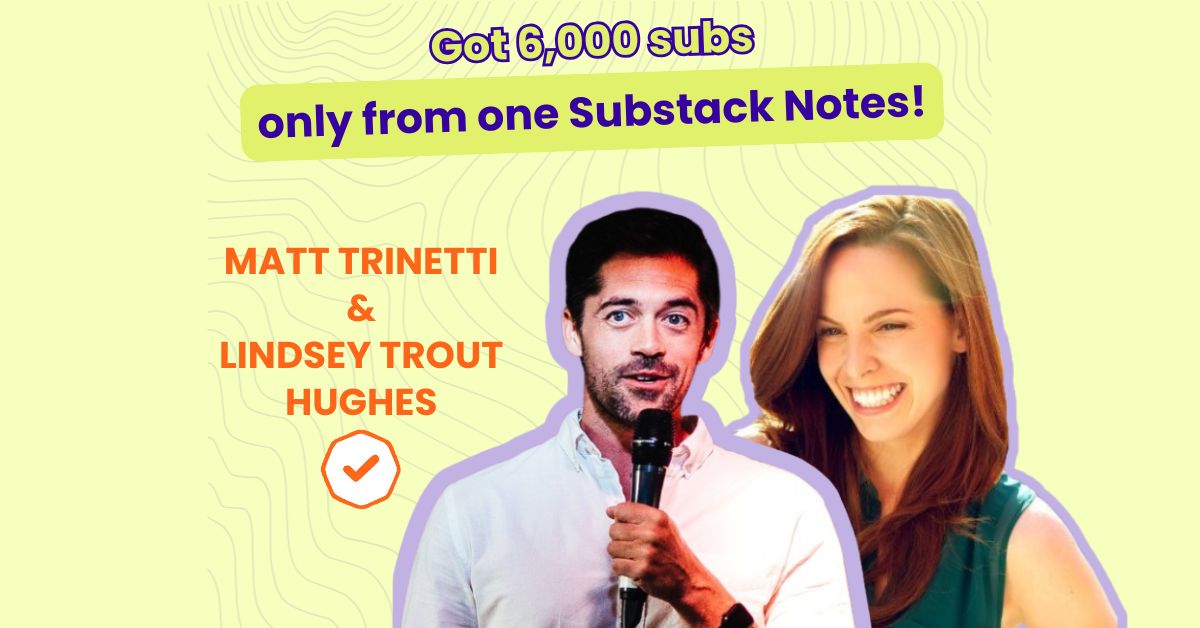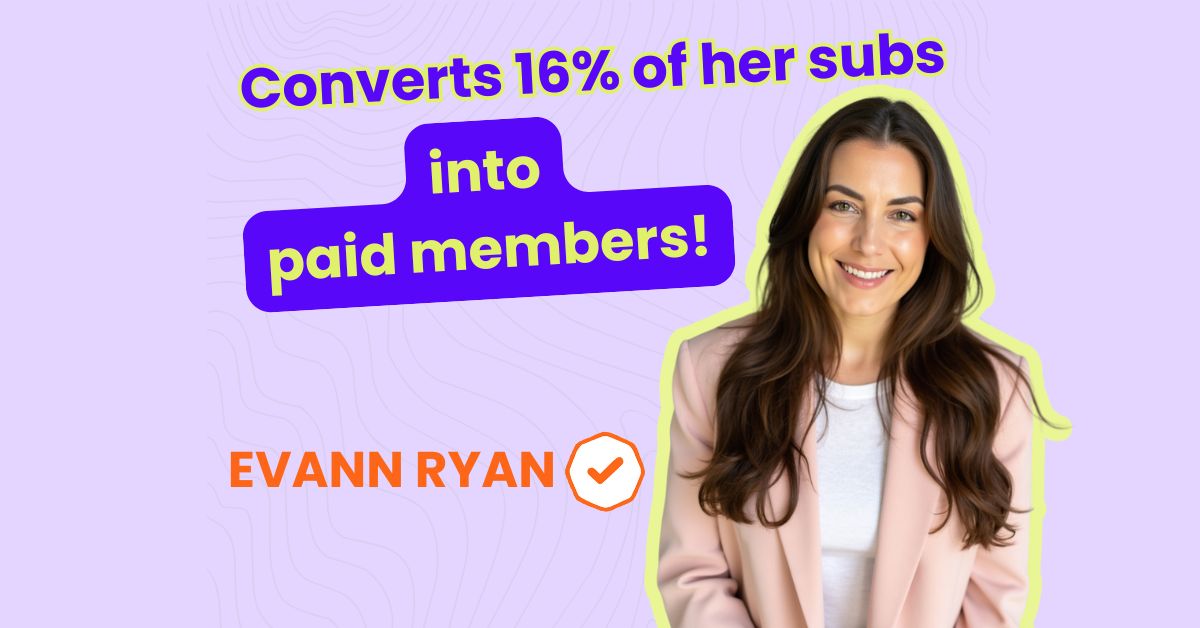Interview Date: November 29, 2024
Table of Content
- Meet Russell Nohelty
- Newsletter Identity Card
- Tool stack
- How he started his newsletter
- Growth guideline to over 46,000 subscribers
- Paid subscription strategy
- Personal & professional impact of running a newsletter
- If he had a chance to start over
- Biggest advice to newsletter creators
MEET THE CREATOR
Russell Nohelty is a USA Today bestselling author, speaker, publisher, and a six-figure creative human since 2017.
He has run a small press called Wannabe Press since 2015 where they have put out 50+ titles, and in the past few years, their revenue has increased from $10k/mo to $30k/mo.
Besides his six-figure businesses, he runs a newsletter called The Author Stack where he shares business strategy for authors with over 46,000 subscribers and almost 1,000 paid members.
In this interview, Russell talked about
- Why he started a newsletter while running a 6-figure business
- Step-by-step growth strategies to reach over 46,000 subscribers
- His paid subscription strategies to reach over 1,000 paid members
- Why he advises newsletter operators to diversify their monetization channels
Enjoy!
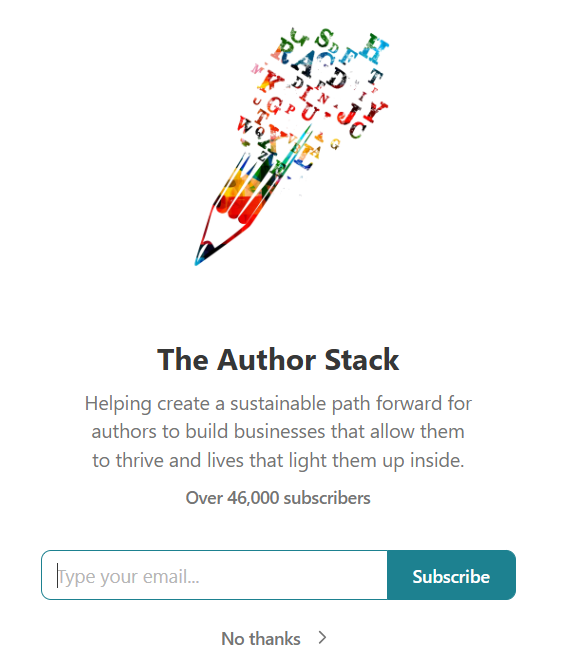
NEWSLETTER IDENTITY CARD
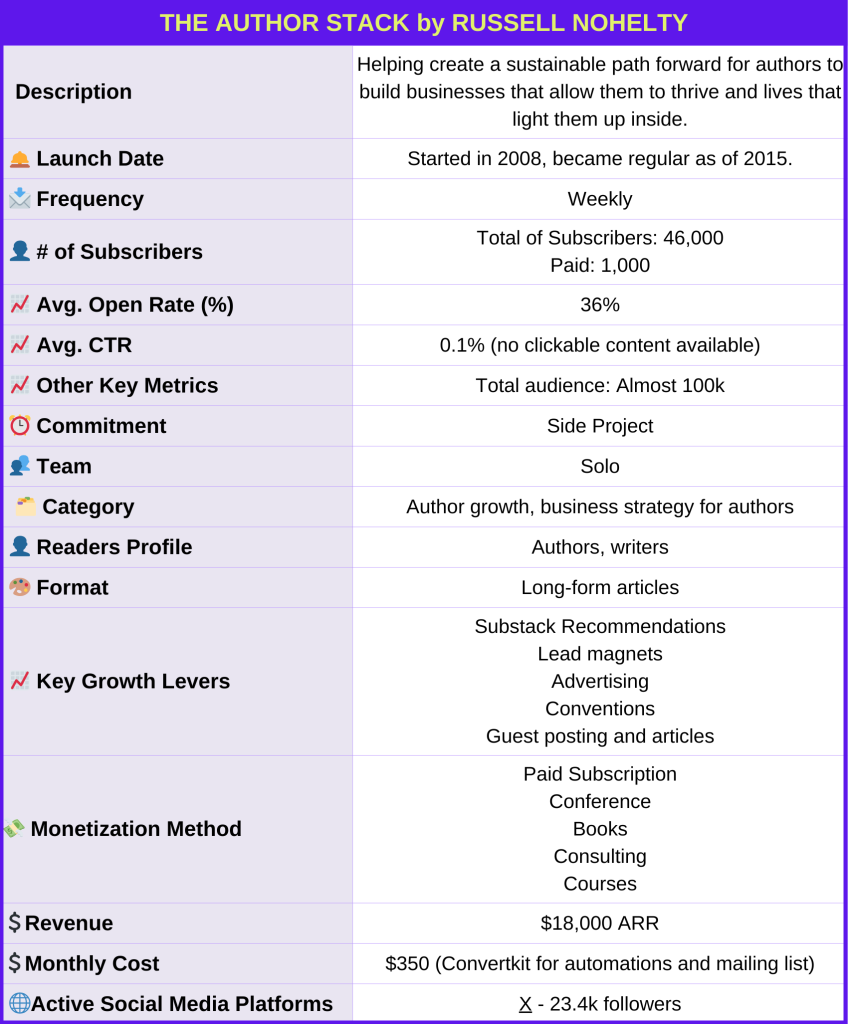
TOOL STACK
- ESP: Substack
- Writing: Word
- Task Management: Gmail
- Curation & Note taking: Substack, Word, Gmail, ChatGPT
- Design of visuals design: Substack, Canva
- Growth: Substack, Facebook, Sparkloop*, Refind, Kickstarter
- Webinars: Zoom
- Digital Products: Teachable
- Affiliate: Teachable, ThriveCart
- Payments: Stripe, Square, ThriveCart, Teachable
START
As an author of over 40 books, how and why did you start The Author Stack newsletter and what is its role in your life?
I’ve been doing this kind of work since 2008 when I started my first blog, The LA Grind. It was terrible, but the idea was to share where I was in my journey and what I learned. I recently went through it, and some things still hold up even after 15+ years.
That morphed into a podcast called The Business of Art, and from there, people started to ask me lots of questions, which I compiled into a book called How to Build Your Creative Career, which then morphed into a blog called The Complete Creative and another book called How to Become a Successful Author.
That became courses and consulting and lots of other things, but I completely burned out on all that stuff in 2020 and licensed the publishing rights to my future business partner Monica Leonelle, who took a lot of my work and incorporated it into our Book Sales Supercharged series, and the breakout hit of that series, Get Your Book Selling on Kickstarter.
From there things kept spiraling until it didn’t make sense to not go all-in on non-fiction again. During that time, Monica kept talking about how much growth she was having with Substack, like bonkers organic growth I didn’t believe could be true unless she was a wizard.
Then, I tried it myself, right before Substack released Notes, and things grew really rapidly from there. I immediately understood how to use Substack, and since it was a small platform, it was easy for me to develop a plan to become one of the top names for the platform.
I tend to get obsessed with platforms until I learn everything about them. So, I spent a lot of time, I’m talking hundreds, maybe thousands of hours, trying to figure it out, and for most of that time, I wasn’t making much money. However, it kept growing over time until it was one of the best profit centers in my business.
How do you position newsletters as a channel for writers, considering the changing landscape of publishing?
Since 2008, my philosophy has really been about telling people what nobody else will talk about, usually because it’s unprofitable to do so at scale.
Creatives do not like thinking about business, and it’s still an uphill battle to get there. People come to me saying “Why doesn’t anyone teach this in college?” and I’m like “I have been here doing this work. You just had to be ready to receive it.”
The reason I burnt out before is because nobody wanted to hear it, and I couldn’t keep doing that work and hitting a brick wall. It wasn’t even the money. It was just discouraging because creatives think knowing business sullies their art, which isn’t true.
Most creative people do things that are antithetical to their growth, and shoot themselves in the foot without knowing it. Once you see what you’re doing “wrong”, it’s freeing.
I actually don’t care if you read what I have to say and then go do things that are going to make no money, as long as you go in with that knowledge from the start.
It’s getting a lot easier, ironically, now that things are getting harder for creatives. Writers now want to know why they aren’t making money.
That said, writers aren’t wrong to be skeptical about business strategy. 99.9% of business books aren’t built with creatives in mind. Not to be a special snowflake, but making art is very different from selling to a “pain point”.
Finding a “hot niche” and serving it is something most creative people just don’t care about, but they are very interested in finding people who resonate with their work and their view of the world.
Publishing is a terrible business model. It’s highly competitive, with race-to-the-bottom pricing, and terrible margins. If you went to a business school and pitched publishing, the class would laugh you out of the room.
People look down on artists, but they are actually doing the hardest work in the world, which is trying to sell something nobody needs to survive to people who already have everything they could ever want available to them for free.
“There really isn’t that big a challenge in growing a business if you are agnostic to what you sell, who you serve, and what you charge. I could show you how to do that in under an hour, but selling something that nobody wants, but everyone needs to make life worth living, is a challenge.”
There are literally no other resources online like The Author Stack. Zero, and I know because if there was I wouldn’t have to write what I write. I only write it because nobody else will talk about it.
My goal is to write in ways that connect craft and commerce, and show that it doesn’t have to be icky to make money. In fact, it’s how you do more of the work you love.
It helps that I’ve done it the hard way for most of my career and succeeded, so I’m forged in fire, and people trust what I have to say because I was right there in the trenches for close to 20 years doing creative work at a high level.
It also helps that I literally don’t care if you read my work. I say what I say because you need to hear it, even if it makes you feel bad and you hate it.
GROWTH
You grew your subscriber number to 46,000 in less than 2 years. This is impressive. How did you gain your first 1,000 subscribers?
Well, it’s really the work of a decade. I brought 27,000 people to Substack that had been on my list as far back as 2015, and then slowly culled that down to 17,000 over the summer, but the way I built that first thousand was through conventions and Kickstarter.
I am very good at conventions, even though I can’t really do them anymore, and it’s the easiest way to get somebody excited about your work quickly and make a connection with you.
Then, I would use Kickstarter to generate revenue to build more products that I would sell at shows, and continued like that until the pandemic. I have one of the weirdest paid subscriber graphs ever.

Growth strategies can vary at different stages of a newsletter journey. Which strategies did you use to grow over 44,000 subscribers?
1,000 – 10,000 Subscribers
Once I had that base of 1,000 subscribers, I added in advertising spend and specifically something I call viral builders, which are basically sophisticated, highly targeted viral giveaways that built my list to 175,000 at one point, but I eventually cut that down to an engaged list of 20,000.
For years, I kept building up my list, running them through automation designed to sell them, and then culling people who didn’t at least open my emails.
I am huge on segmentation, and so I have hundreds of tags to tell me what people are doing when they take action, and dozens of automation running in the background that I built over the years.
10,000 – 25,000 Subscribers
The main difference here was that I got much better at monetizing to fund more aggressive growth. I put out more products, more different types of products, and offered services that helped me build and grow while making money doing it.
In general, I have spent most of my life working in “seasons”, where I spend money building and then spend 3-6 months monetizing those subscribers to build up a nest egg to do it again, but during this stage, I was doing a lot of consulting and author services that allowed me to do both at once, which was nice.
25,000 – 40,000 Subscribers
This would encapsulate my “Substack era”. While I relied a lot on organic growth from Substack’s algorithm (back when it was a way more powerful agent of growth than it is now), I also hired a growth team to spearhead Facebook ad growth (which didn’t work) and Sparkloop (which worked better for opens then clicks).
I also worked with Refind and Beehiiv to grow my subscriber base quickly. We were trying to monetize for advertising and sponsorships, and it just didn’t work. Our Ad CTR was just too low to attract sponsors. We also tried a daily newsletter for a quarter, and it didn’t take off at all.
40,000+ Subscribers
I don’t do any advertising now. I pretty much rely on word of mouth and the articles I write will have virality.
Currently, they are opened and read by over 20,000 people a week, which is more than the entire newsletter at this point last year. The more I expand my reach, the more it grows, and the more leverage I build in my business.
After we hit 40,000 subscribers, bigger, more exciting opportunities started to happen consistently for us. I’ve always done interviews, but bigger and more influential people started to contact me recently.
I haven’t talked about this yet, but easily my biggest growth driver in the past decade is the Dream100 stuff I learned a decade ago, which was all about networking with the right people and working with ever more influential people as you grow.
Things that didn’t work well to drive growth when I was working with people who had 100-500 on their list worked really well when the people I worked with had tens of thousands of subscribers reading and listening to them.
There is so much power in having a bigger list that goes beyond how much money you make. Doors opened for me recently that have been closed to me since the beginning, and people I admire are reaching out to me instead of the other way around.
We also own a conference called Writer MBA in New Orleans which is really helpful toward that end.
Regarding growth efforts, what would you do differently if you had a chance to start over?
I would join Substack quicker and spend way more time trying to get to 50,000 subscribers as fast as possible.
I definitely spent too much time in the 10,000-20,000 subscriber range, which was great for my money situation, but the opportunities afforded me now as I approach 50,000 are much more valuable than I ever had back then when I was thinking smaller.
Don’t get me wrong, 10,000 is a great list size and you can build a six-figure business from it (and I did!), but I do think you need to get higher to have the influence and ear of the industry.
MONETIZATION
What is the primary monetization channel for your newsletter?
The newsletter only accounts for about 10% of our revenue. Most of our revenue comes from our conference, Writer MBA, our Future of Publishing Mastermind, our book launches, and our courses.
When was the right time for you to start paid subscription for your newsletter? How long did it take to monetize your newsletter?
I consider The Author Stack to be an introductory product, and I turned on paid when I first started to take Substack seriously, even though I wouldn’t pull the trigger on it for a few more months.
“My goal is to get somebody into the subscription so they have everything they need to learn the language of our philosophy. Once they have that, then I hope they upgrade to joining us at a deeper level.”
As for monetization, it really didn’t become significant until recently. At the end of 2023, we were making $9,000/yr on subscriber revenue, which was less than 5% of our revenue in 2023 even though I spent 80% of my online time on Substack.
Right now we’ve doubled that in 2024, which puts our revenue at about 10% of revenue, which is significant. I want to double that next year, too.
I should also mention here that I offer steep discounts to subscribers just to get them behind the paywall. I’ve offered subscriptions for $1/yr at the beginning just to get people through the door.
We have over 950 paying members, but they only pay about $20/yr for their subscription, which is about what they would pay for a book from me, and I think that’s fair.
Here is my growth curve.
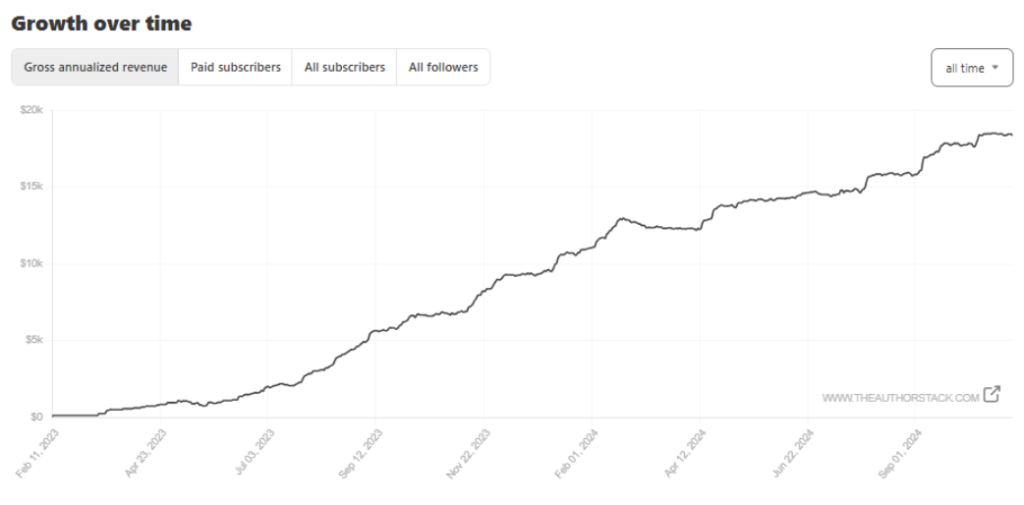
How many paid subscribers do you have? What are your strategies to convert free subscribers into paid ones or to gain new paid subscribers?
We technically have just over 1,000 paying members (950 paid, 3 trial, 18 gifts, 36 comps), but I only track paid members as both trials and gifts tend to disappear more quickly than those who pay for their own membership.
The best driver is easily our “pledge drives”. Every quarter we have a pay-what-you-can-afford event where you can get discounts up to 80%. Every time I do one I get 100-200 new paid members. Then, we also do “flash sales” a couple of times, which are one-day events with steep, steep discounts down to $8/yr.
Since I have 46,000 subscribers, even if I only pick up 0.3% every time I host an event, that is significant. People try this same strategy with 500 subscribers, and it just isn’t worth the effort. Scale has its own leverage.
We also have almost 900 exclusive member posts, including books, articles, courses, and more, which people can access, and I will often give additional articles during the week above my one free article to paid members.
We don’t have a lot of member chats or anything, but having that massive backlog of content is really helpful to converting members.
You offer different lead magnets and other stuff (see here) such as e-books both for your paid members and free subscribers. How did you decide what to offer differently to paid subscribers to make it compelling for them to join as paid members?
Since I have such a massive back catalog of work, I can offer just about anything as a free lead magnet and expect when people see what’s behind the paywall they will be blown away.
I have offered each of our books as a lead magnet before, but I usually focus on the three that I wrote on my own (as we find for my audience books hold the most value and get the quickest conversion.):
- How to Build a Creative Career
- How to Become a Successful Author
- Advanced Growth Strategies for Authors
Before I had such a big back catalog, we would take our best-performing articles and create ebooks from them, which worked really well, too. New subscribers get two of them still when they subscribe, even for free (How to Make a Living as a Self-Published Author and How to Land a Book Publishing Contract).
Probably, if you subscribe, one of those two things will interest you and give you some actionable steps to move forward.
What are your biggest learnings when applying for a successful paid subscription?
No subscription is going to take off on day one. I’m a big proponent of the linchpin method, which is all about using a subscription as an undercurrent of your business, letting it build over time, and not putting a ton of resources into it until it starts to take off.
I know I put a lot of time into Substack, but that’s because I naturally talk about this stuff and my articles were the anxious burn-off of my life. I wasn’t doing extra work. I was just doing the work I was already going to do anyway. I just did it on Substack instead of somewhere else.
Now, I’m going to contradict myself, because I do think when you start any project you need to give it 3-6 months of focused attention to see if it even works for you. I put max effort in Substack for 6 months until I saw there was traction there, and then we put real resources, and money, behind it.
Also, nobody really does launch events for their newsletter, at least not more than once, which I think is ridiculous. We have launched and relaunched this membership 6-8 times since we started to work on it. Almost nobody becomes a paying member naturally, although they are free to do so if they want. We get almost all our growth through these pledge drives.
If you don’t stand up and say “Did you know you can buy this?” then almost nobody is going to put two and two together.
SYSTEM AND PRODUCTIVITY
You run lots of different newsletters besides your author role. How do you manage your time to keep up with all of your newsletters? Do you have any productivity tips?
Oh, that’s easy. I do almost all of them poorly. The Author Stack was the only one that really caught on with people, so I spent almost all my time on it. The others just exist to catch the random subscriber over time.
That said, I also have a mailing list on Convertkit, which houses both my Wannabe Press and Author Stack subscribers, and I send emails there, too but those are more promotional emails that don’t take me very long to create. I spend no more than 30 minutes on any of those emails, and usually they are straight pulled from something else I wrote.
Honestly, I don’t do much all day, except think and write, so it’s easy to make time for anything I want to do. I went to a bunch of business conferences this year, wondering why I can’t get beyond $30k/mo, and I realized a lot of people there put in real work, like 12-16 hour days, and I just don’t. I do sit at my computer that long, but usually, I’m staring off into space or listening to a novel while I put around.
“To me, entrepreneurship isn’t about making the most money. It’s about having the most freedom. I’ll do almost anything to get more time freedom, but I’m just not willing to spend that type of time making more money.”
As for productivity, I actually have a course called 10x Your Productivity, and it’s mostly about time blocking, batching, and focusing on the right things that will move the needle the most with the least effort.
People love doing things that don’t create leverage, but if you create leverage in your business, you can do a lot with very little effort.
IMPACT & LEARNINGS
How did building The Author Stack newsletter contribute to your life professionally and personally?
I’ve never had a buffer of money coming in every month/year. I would get fat on a launch and then burn it all away before being a little scramble man trying to get more money again. Having a base of money that grows over time is like having a job without a boss.
It takes away a lot of anxiety, but don’t get me wrong, I probably could have made more money doing launches during this time. Subscriptions are hard and you don’t see the value until you really do.
“If I wasn’t so interested in being an industry leader and gathering influence, I probably would have given it up way before I got to this point.”
I can make more money sending promotional emails in a month than I do on my subscription. Unless you use it as a funnel for something else, I’m not sure it’s worth it for most people, as subscriptions are the hardest thing to sell. If you are going to do it, then I would try to create a newsletter around a slate of other products so it can grow over time without pressure.
What would you do differently if you had a chance to start over The Author Stack?
This is really hard because I already had a bunch of businesses working that I was trying to thread this between. So, I did a bad job doing that, but it somehow does thread in there without diminishing any of my other work. So, I don’t think I could have done anything differently, but I probably would have set it up differently looking back so it better integrates with at least one part of my business.
Now, we spend a lot of time trying to position it so it doesn’t take away from anything else, and I’m not sure we do a great job of it all the time. I would really look into where this stood on my value stack and wonder if it was worth it.
Frankly, I’m not sure it would be in the end. Maybe I shouldn’t say that in an interview promoting successful newsletters, but this is easily the hardest thing I’ve ever had to sell, and I have sold a book about a pickle drawn by me (and I can’t draw).
That said, if I knew how hard it was to make a business work, any business work, I’m not sure I would have done any of it. I’m not one of those people who magically makes money in their sleep. I grind for it, and it’s exhausting, even though it gives me a ton of freedom.
What would it be if you had the right to give one piece of advice to aspiring newsletter creators?
“Your first sale probably won’t, and shouldn’t, be your membership. Try to think of other products, like courses and books, that can work with your membership, but give people discrete wins they can take without going all in on a membership with you.”
People will usually need to subscribe for a long time before they become paying members, but they will buy a book much more quickly, even if it costs much more than a subscription and gives them much less.
People are very wary of subscriptions, and streamers aren’t doing us any favors by taking things off the platform, but they are still winning to buy a book from you. If you’re not packaging your work up at least once a year and selling it, then you’re leaving a lot of money on the table. I do that at least 1-2 times a year and it’s great.
Make sure to launch them on your own site or Kickstarter first though, so you can capture their information. It’s great to have them as retailers, but I believe you should think of retailers as a funnel to your own direct pipeline.
Final words, if you have any?
A newsletter should be a part of your ecosystem, not the whole thing. Having a thriving business involves making a direct sales infrastructure to help you grow, which is what we help you do at The Author Stack.
3 Popular The Author Stack Issues
- How do I market myself without feeling gross about it?
- The era of rapid trend cycles in publishing
- Platform, audience, and assets
Where to find Russell Nohelty
*indicates affiliate links

